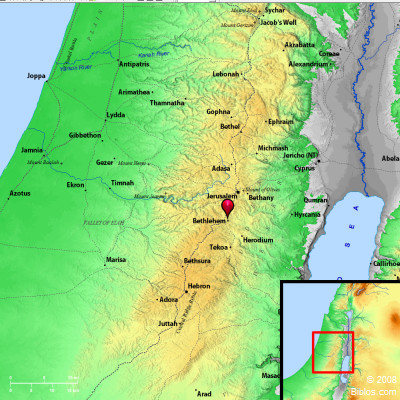Encyclopedia
BETHLEHEMbeth'-le-hem (bethlechem; Baithleem, or Bethleem, "house of David," or possibly "the house of Lakhmu," an Assyrian deity):
I. Bethlehem Judah:
Bethlehem Judah, or EPHRATH or EPHRATHAH (which see) is now Beit Lahm (Arabic = "house of meat"), a town of upward of 10,000 inhabitants, 5 miles South of Jerusalem and 2,350 ft. above sea level. It occupies an outstanding position upon a spur running East from the watershed with deep valleys to the Northeast and South It is just off the main road to Hebron and the south, but upon the highroad to Tekoa and En-gedi. The position is one of natural strength; it was occupied by a garrison of the Philistines in the days of David (2 Samuel 23:14 1 Chronicles 11:16) and was fortified by Rehoboam (2 Chronicles 11:6). The surrounding country is fertile, cornfields, fig and olive yards and vineyards abound. Bethlehem is not naturally well supplied with water, the nearest spring is 800 yds. to the Southeast, but for many centuries the "low level aqueduct" from "Solomon's Pools" in the ArTas valley, which has here been tunneled through the hill, has been tapped by the inhabitants; there are also many rock-cut cisterns.
1. Early History:
In 1 Chronicles 2:51 Salma, the son of Caleb, is described as the "father of Bethlehem." In Genesis 35:19; Genesis 48:7 it is recorded that Rachel "was buried in the way to Ephrath (the same is Beth-lehem)." Tradition points out the site of Rachel's tomb near where the road to Bethlehem leaves the main road. The Levites of the events of Judges 17 Judges 19 were Bethlehemites. In the list of the towns of Judah the name Bethlehem occurs, in the Septuagint version only in Joshua 15:57.
2. David the Bethlehemite:
Ruth, famous chiefly as the ancestress of David, and of the Messiah, settled in Bethlehem with her second husband Boaz, and it is noticeable that from her new home she could view the mountains of Moab, her native land. David himself "was the son of that Ephrathite of Bethlehem-judah, whose name was Jesse" (1 Samuel 17:12). To Bethlehem came Samuel to anoint a successor to unworthy Saul (1 Samuel 16:4): "David went to and fro from Saul to feed his father's sheep at Bethlehem" (1 Samuel 17:15). David's "three mighty men" "brake through the host of the Philistines, and drew water out of the well of Beth-lehem, that was by the gate, and took it, and brought it to David" (2 Samuel 23:14, 16). Tradition still points out the well. From this town came those famous "sons of Zeruiah," David's nephews, whose loyalty and whose ruthless cruelty became at once a protection and a menace to their royal relative: in 2 Samuel 2:32 it is mentioned that one of them, Asahel, was buried "in the sepulchre of his father, which was in Bethlehem."
3. Later Bible History:
After the time of David, Bethlehem would appear to have sunk into insignificance. But its future fame is pointed at by Micah (Micah 5:2): "But thou, Beth-lehem Ephrathah, which art little to be among the thousands of Judah, out of thee shall one come forth unto me that is to be ruler in Israel; whose goings forth are from of old, from everlasting."
In the return of the Jews captive Bethlehemites re-inhabited the place (Ezra 2:21 Nehemiah 7:26 "men"; 1 Esdras 5:17 "sons").
4. The Christian Era:
In the New Testament Bethlehem is mentioned as the birthplace of the Messiah Jesus (Matthew 2:1, 5 Luke 2:4, 25) in consequence of which event occurred Herod's "massacre of the innocents" (Matthew 2:8, 16). Inasmuch as Hadrian devastated Bethlehem and set up there a sacred grove to Adonis (Jerome, Ep. ad Paul, lviii.3) it is clear that veneration of this spot as the site of the Nativity must go back before 132 A.D. Constantine (circa 330) founded a basilica over the cave-stable which tradition pointed out as the scene of the birth, and his church, unchanged in general structure though enlarged by Justinian and frequently adorned, repaired and damaged, remains today the chief attraction of the town. During the Crusades, Bethlehem became of great importance and prosperity; it remained in Christian hands after the overthrow of the Latin kingdom, and at the present day it is in material things one of the most prosperous Christian centers in the Holy Land.
II. Bethlehem of Zebulun:
Bethlehem of Zebulun (Joshua 19:15) was probably the home of Ibzan (Judges 12:8) though Jewish tradition is in support of (1). See Josephus, Ant, V, vii, 13. This is now the small village of Beit Lahm, some 7 miles Northwest of Nazareth on the edge of the oak forest. Some antiquities have been found here recently, showing that in earlier days it was a place of some importance. It is now the site of a small German colony. See PEF, I, 270, Sh V.
E. W. G. Masterman




